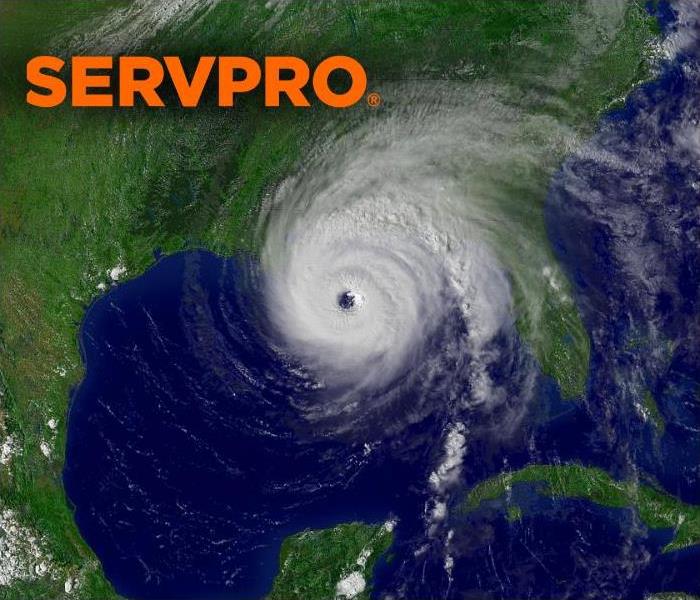Hurricane Facts and the Dangers They Present | SERVPRO® of Montgomery
7/19/2022 (Permalink)
 The aftermath of a hurricane can be destructive and devastating. SERVPRO® of Montgomery is here to help ® with any storm cleanup and restoration.
The aftermath of a hurricane can be destructive and devastating. SERVPRO® of Montgomery is here to help ® with any storm cleanup and restoration.
Hurricanes are among nature's most powerful and destructive phenomena. On average, 12 tropical storms, 6 of which become hurricanes, form over the Atlantic Ocean, Caribbean Sea, or the Gulf of Mexico each year.
The word "hurricane" comes from Huracan, a name for the god of evil on some islands in the Caribbean. Never fear, though; SERVPRO® of Montgomery is here to educate you about hurricane facts and storm dangers.
Hurricanes are damaging in many ways. On average, hurricanes will travel about 300 miles before dissipating, leaving behind a path of destruction. They can even dump 10 to 15 inches of rain on the areas they pass over, causing mass flooding and water damage.
We often see news coverage of physical damage and displaced families. Sadly sometimes, we also see reports of injuries and casualties. Hurricanes have caused approximately 1.9 million fatalities worldwide over the past 200 years. Ninety percent of hurricane-related deaths result from storm surges, reaching over 20 feet high and extending nearly one hundred miles. Hurricanes cause more fatalities than any other type of storm.
However, when the news coverage ends, a looming uncertainty and the reality of rebuilding your future remains.
The frequency of extreme weather events is taking its toll on many areas and industries across the nation, and Alabama is no exception. Our state alone has suffered from 83 tropical storms and cyclones in the last 20 years. We have also experienced three significant hurricanes that directly hit our coast.
While hurricanes pose the greatest threat to life and property, tropical storms and depressions also can be devastating. Storm surges, inland flooding from heavy rains, destructive winds, tornadoes, and high rip currents can be primary hazards.
Storm Dangers To Be Aware Of:
- Storm surges are historically the leading cause of hurricane-related deaths in the United States.
- Storm surges can travel inland, especially along bays, rivers, and estuaries.
- Flooding from heavy rains is the second leading cause of fatalities from landfalling tropical cyclones. Flooding can persist for days after a storm has dissipated.
- High winds can destroy buildings and manufactured homes. Signs, roofing material, and other items left outside can become flying missiles during storms.
- Tornadoes can accompany landfalling tropical cyclones. These tornadoes typically occur in rain bands far from the storm's center.
Hurricane Facts:
- Hurricanes in the Southern Hemisphere spin clockwise while hurricanes in the Northern Hemisphere turn counterclockwise.
- The right side of a hurricane in the Northern Hemisphere is often more assertive regarding winds, tornadoes, and supercells.
- A hurricane makes "landfall" when its center, not its edge, crosses the coastline.
- Hurricanes never combine to form one stronger storm. However, the storms may circle each other, known as the Fujiwhara effect.
- Hurricane names come from the World Meteorological Organization. Each list repeats every 7th year. However, officials will retire names of hurricanes that have caused many damages or fatalities.
- The costliest hurricane worldwide is believed to be Hurricane Katrina, with overall damage estimated at over one hundred and fifty billion dollars.
- Hurricanes typically last around ten days but can stay alive for several weeks.
Although hurricanes can cause terrible damage, they are essential to Earth's complicated weather system. Like giant fans, they take hot air from the tropics and move it toward the poles. They help balance temperatures and moisture around the Earth. Without hurricanes and other storms, vast areas of the planet would be too hot for animal and human life.
Dangerous waves produced by a tropical cyclone's strong winds can pose a significant hazard. These waves can cause deadly rip currents, significant beach erosion, and damage to structures along the coastline, even when the storm is more than 1,000 miles offshore.
If your home or business should sustain water damage from storms or floods, SERVPRO has local technicians on standby 24/7 for emergencies and is ready to handle your restoration needs. Click or call today to find out how we can help when disaster strikes.






 24/7 Emergency Service
24/7 Emergency Service